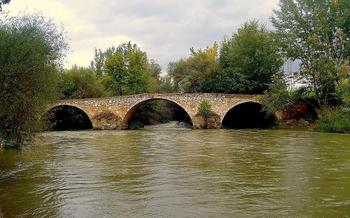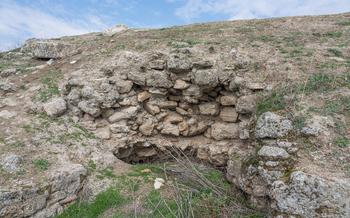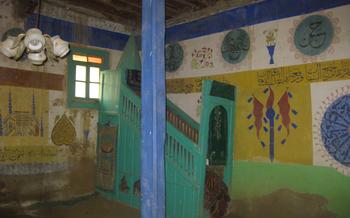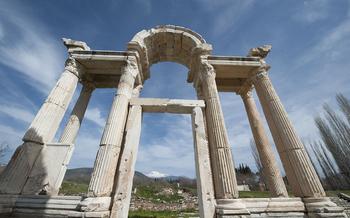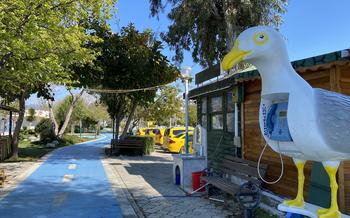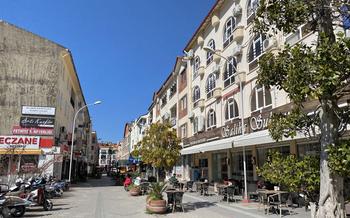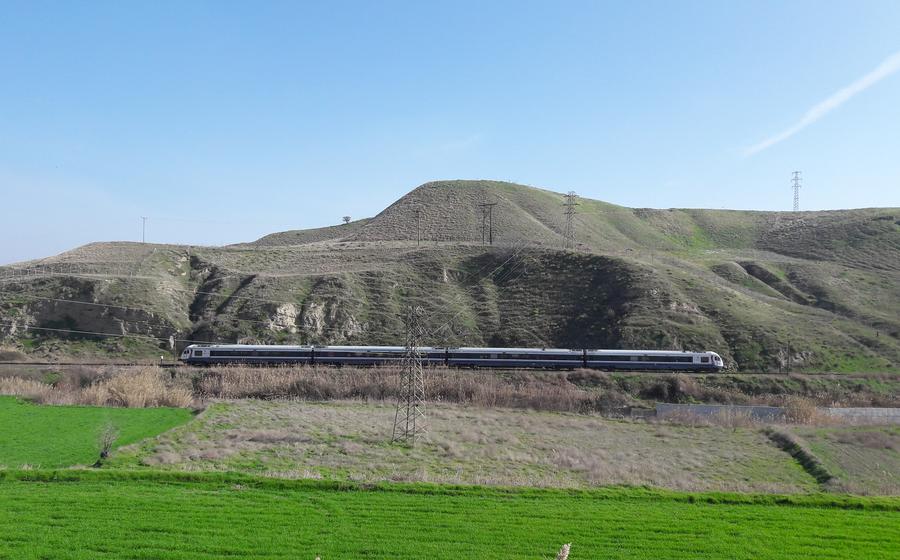
Tripolis Ancient City
- Historical Background:
- Location and Accessibility:
- Exploring the Ruins
- The Theater
- The Agora: A Bustling Marketplace and Social Hub
- The Temples:
- The Necropolis: A Journey Through the Past
- The Museum
- Local Cuisine:
- Festivals and Events: A Journey into Cultural Heritage
- Accommodation and Amenities
- Photography Opportunities: Capturing the Essence of Tripolis and Denizli
- Guided Tours and Activities
- Local Crafts and Souvenirs
- Insider Tip: Uncovering the Hidden Gem of Kaklık Cave
Historical Background:
Journey back in time to the ancient city of Tripolis, nestled in the heart of Denizli, Turkey. Its story unfolds from the Hellenistic period, around the 3rd century BC, when it emerged as a significant city in ancient Caria. Tripolis flourished as a religious center, boasting impressive temples and sanctuaries that drew pilgrims from across the region. Over the centuries, it witnessed the influence of various civilizations, including Greek, Roman, and Byzantine, each leaving their mark on its architectural legacy. Today, Tripolis stands as a testament to the rich tapestry of history that shaped this ancient land.
Location and Accessibility:
Tripolis, an ancient city steeped in historical significance, is situated near the modern city of Denizli in southwestern Turkey. To reach this archaeological wonder, visitors can take advantage of the excellent transportation network in the region. From Denizli, regular buses and taxis are readily available, making the journey to Tripolis a breeze. The ancient city lies just a short distance from the bustling city center, offering easy access for those eager to explore its captivating ruins.
Additionally, Tripolis' proximity to other popular tourist destinations in the region makes it an ideal starting point for further exploration. The world-famous travertine terraces of Pamukkale and the ancient ruins of Hierapolis are both within easy reach, inviting visitors to immerse themselves in the rich cultural heritage of the region. A detailed map or directions can be found online or at local tourist information centers to assist travelers in navigating the area effortlessly.
Exploring the Ruins
Tripolis, with its rich history and impressive ruins, offers a captivating journey into the past. The ancient city reveals itself through its well-preserved walls, gates, and streets, providing a glimpse into the lives of its former inhabitants. As you wander through the ruins, you'll encounter the theater, agora, temples, and other significant structures that showcase the architectural prowess of the ancient world.
One of the highlights of Tripolis is its theater, an impressive structure that once hosted theatrical performances and public gatherings. Its well-preserved seating rows, stage, and acoustics create an immersive experience, allowing you to imagine the vibrant atmosphere of ancient performances.
The agora, the bustling marketplace and social center of the city, is another must-see. As you explore the agora, you'll discover the remains of shops, stalls, and public buildings, providing a glimpse into the economic and social activities of Tripolis.
The city's temples, dedicated to various deities, are testaments to the religious significance of Tripolis. Each temple boasts unique architectural features and intricate carvings, showcasing the artistry and devotion of the ancient inhabitants.
Archaeological excavations are ongoing at Tripolis, revealing new insights into the city's past. As you explore the ruins, you'll have the chance to witness these excavations firsthand and learn about the latest discoveries that shed light on the ancient world.
Whether you're a history buff, an architecture enthusiast, or simply someone who loves to explore ancient ruins, Tripolis offers an unforgettable journey into the past, allowing you to connect with the rich cultural heritage of the region.
The Theater
Constructed during the Hellenistic period, the theater of Tripolis stands as a testament to the city's cultural and artistic heritage. With its impressive size and architectural features, it served as a central venue for theatrical performances, concerts, and public gatherings.
The theater's design showcases the refined craftsmanship of its builders, with tiers of seating arranged in a horseshoe shape. The stage, adorned with intricate carvings and statues, provided a grand platform for actors and performers to entertain the city's inhabitants.
The theater's acoustics are truly remarkable, allowing performers' voices to carry effortlessly throughout the auditorium. This exceptional acoustic quality makes it an ideal venue for live performances, creating an immersive and intimate atmosphere for audiences.
During my visit to the theater, I was struck by the sense of history that permeated the air. I could almost envision the vibrant crowds that once filled the seats, cheering and applauding the performances that graced this ancient stage. It was a truly magical experience that transported me back in time.
The Agora: A Bustling Marketplace and Social Hub
The agora, or marketplace, was the heart of ancient Tripolis, a vibrant center where trade, commerce, and community life intersected. Step into the agora, and you can almost hear the hum of activity as merchants hawked their wares, shoppers bartered for the best prices, and citizens gathered to exchange news and gossip.
Imagine walking through the bustling streets, lined with shops and stalls selling everything from fresh produce and spices to pottery, textiles, and tools. The air is filled with the scents of exotic perfumes, grilled meats, and freshly baked bread. Merchants from far and wide converge here to display their goods, creating a symphony of sights, sounds, and aromas.
Beyond the commercial transactions, the agora served as a crucial social hub for the people of Tripolis. It was a place to meet friends, discuss politics, and share stories. Public buildings, such as the bouleuterion (council house) and the prytaneion (government building), were located within the agora, reflecting its importance as a center of civic life.
As you wander through the agora, let your imagination transport you back to ancient times. Picture the bustling crowds, the lively conversations, and the sense of community that permeated this vibrant space. The agora was not merely a marketplace but a testament to the social and economic vitality of Tripolis, where people came together to forge connections and build a shared identity.
The Temples:
Tripolis was home to several impressive temples, each dedicated to a different deity and showcasing unique architectural styles. The Temple of Apollo, the city's patron god, stands as a testament to the grandeur of ancient Greek architecture. With its towering columns, intricate friezes, and well-preserved pediments, it transports visitors back in time to the days when oracles were consulted, and rituals were performed in honor of the sun god. The Temple of Artemis, dedicated to the goddess of the hunt and nature, features elegant Ionic columns and exquisite carvings depicting scenes from Greek mythology. Its serene atmosphere invites visitors to reflect on the deep connection between the ancient Greeks and the natural world.
Another significant temple in Tripolis is the Temple of Zeus, the king of the gods. Its imposing size and sturdy construction evoke a sense of awe and reverence. The temple's well-preserved altar and surrounding columns provide a glimpse into the religious practices and ceremonies that took place within its sacred walls.
These temples, with their distinct architectural features and religious significance, offer visitors a fascinating journey into the spiritual beliefs and practices of the ancient inhabitants of Tripolis.
The Necropolis: A Journey Through the Past
In the shadow of ancient Tripolis, the necropolis stands as a silent testament to the lives and deaths of its former inhabitants. Located just outside the city walls, this sprawling burial ground offers a glimpse into the funerary customs and beliefs of the ancient Carians.
The necropolis is a treasure trove of archaeological discoveries, with various types of tombs and burial practices represented. From simple rock-cut graves to elaborate chamber tombs, each burial site tells a story of the life and legacy of the person laid to rest.
The most impressive tombs are the family mausoleums, with their intricate carvings and architectural features. These mausoleums often housed multiple generations of a family, symbolizing the continuity and strength of their lineage.
As you wander through the necropolis, it's easy to imagine the ancient funeral processions, the mourners paying their respects, and the rituals performed to honor the deceased.
The necropolis is not just a place of death but also a place of remembrance and reflection. It's a reminder that even in the face of mortality, the human spirit endures.
Take a moment to pause and contemplate the lives of Tripolis's ancient citizens as you explore this sacred ground. Their stories, though long gone, are still etched in the stones that surround you.
The Museum
The Tripolis Museum is a treasure trove of artifacts and findings that provide a tangible connection to the ancient city's past. Situated near the archaeological site, the museum houses a diverse collection of sculptures, pottery, coins, jewelry, and other objects excavated from the ruins of Tripolis.
As you step through the museum's doors, you are greeted by an impressive array of marble and bronze sculptures that depict gods, goddesses, and legendary figures. The intricate details and lifelike expressions of these sculptures offer a glimpse into the artistic prowess of the ancient Tripolitans.
Among the highlights of the museum's collection is a stunning marble statue of Aphrodite, the Greek goddess of beauty and love. The statue, with its delicate features and flowing drapery, is a testament to the city's devotion to the goddess.
The museum also boasts a rich collection of pottery, ranging from simple household items to elaborately decorated vases and amphorae. These vessels provide insights into the daily lives of the ancient inhabitants, their culinary practices, and their trade relations with other regions.
In addition to sculptures and pottery, the museum displays a fascinating collection of coins that were minted in Tripolis during ancient times. These coins, adorned with various symbols and inscriptions, offer valuable information about the city's economy, political structure, and its relationship with neighboring cities and empires.
Visiting the Tripolis Museum is an enriching experience that allows you to delve deeper into the history and culture of this ancient city. As you wander through the exhibits, you will gain a profound appreciation for the artistic achievements, religious beliefs, and everyday lives of the people who once called Tripolis home.
Local Cuisine:
Denizli offers a delectable culinary experience, blending traditional Turkish flavors with regional influences. Savor the aromatic dishes prepared with fresh, locally sourced ingredients. Indulge in mouthwatering kebabs, succulent grilled meats, and tantalizing meze platters. Don't miss the regional specialty, keşkek, a hearty dish made from pounded wheat, meat, and spices.
For a taste of authenticity, venture into the charming local restaurants or eateries near Tripolis. Engage with friendly food vendors and immerse yourself in the vibrant atmosphere. Sample traditional Turkish coffee or çay (tea) paired with delightful pastries or sweets. Vegetarians and those with dietary restrictions can find plenty of options, such as fresh salads, vegetable dishes, and delicious meze platters. Embrace the local culinary traditions and savor the unforgettable flavors of Denizli.
Festivals and Events: A Journey into Cultural Heritage
Denizli and its surroundings offer a vibrant calendar of festivals and events that showcase the region's rich cultural traditions and heritage. Immerse yourself in the lively atmosphere of these celebrations to gain a deeper understanding of the local identity.
One of the most significant events is the Denizli Rooster Festival, held annually in May. This unique festival celebrates the iconic Denizli rooster, known for its distinctive crowing and prized fighting abilities. Witness colorful parades, traditional rooster fights, and various cultural performances that bring the city to life.
In August, the Hierapolis Ancient Theatre Festival takes center stage, hosting a series of concerts, plays, and cultural performances within the awe-inspiring ruins of the ancient theater. Experience the magic of ancient acoustics as you enjoy performances under the starry sky, transporting you back in time.
For a taste of rural traditions, visit during the Çameli Shepherd Festival in September. This festival celebrates the nomadic shepherd culture of the region, with traditional music, dance, and food. Witness the herding of sheep and goats, participate in folk games, and savor delicious local cuisine.
These festivals offer an exceptional opportunity to connect with the local community, embrace Turkish hospitality, and gain insights into the diverse cultural heritage of Denizli. Make sure to include these events in your travel itinerary to experience the vibrant spirit of the region.
Accommodation and Amenities
When planning your trip to Tripolis, you'll find a range of accommodation options to suit different budgets and preferences. For a comfortable and convenient stay, consider booking a room at one of the nearby hotels or guesthouses. These establishments offer a variety of amenities, including cozy rooms, delicious dining options, and helpful staff to assist you during your stay.
If you're looking for a more immersive experience, consider staying at a traditional Turkish guesthouse or "pansiyon." These charming accommodations provide a glimpse into local culture and often offer a warm and welcoming atmosphere. Many guesthouses are family-run, and you'll have the opportunity to interact with the friendly locals and learn about their way of life.
In terms of amenities, Tripolis and the surrounding area offer a good selection of restaurants, cafes, and shops. You'll find everything from traditional Turkish cuisine to international fare, ensuring that there's something to satisfy every palate. Transportation options are also readily available, with buses and taxis providing easy access to the ancient city and other attractions in the region.
To ensure a smooth and comfortable stay, it's a good idea to book your accommodation in advance, especially if you're visiting during the peak tourist season. This will guarantee that you have a place to rest and recharge after a day of exploring the wonders of Tripolis and Denizli.
Photography Opportunities: Capturing the Essence of Tripolis and Denizli
Tripolis and Denizli offer a wealth of photographic opportunities for enthusiasts of all levels. The ancient ruins, picturesque landscapes, and vibrant cultural scenes provide a backdrop for stunning images that will capture the essence of your journey.
The ancient city itself is a photographer's paradise, with well-preserved ruins and intricate details that invite exploration through the lens. Capture the grandeur of the theater, the bustling atmosphere of the agora, and the serenity of the temples against the backdrop of the surrounding hills.
Don't miss the magical play of light during sunrise and sunset, which transforms the ruins into a golden spectacle. The warm hues of the setting sun cast long shadows, creating dramatic silhouettes and adding depth to your photographs.
Venture beyond the ancient city to capture the natural beauty of Denizli. The nearby travertine terraces of Pamukkale and the cascading waterfalls of Hierapolis offer unique compositions and breathtaking views.
Remember to respect the cultural heritage and environment while taking photographs. Ask permission before photographing local people, and avoid using flash photography inside museums or religious sites.
Share your Tripolis and Denizli photographs with the world using the hashtag #TripolisDenizli, and inspire others to explore the beauty of this ancient land.
Guided Tours and Activities
Enhance your Tripolis experience by joining a guided tour or engaging in various activities that will deepen your understanding of the ancient city's history and significance. Professional guides bring Tripolis to life, sharing fascinating insights, anecdotes, and historical context that you might miss on your own.
Guided tours are available in various languages, ensuring that visitors from all corners of the globe can learn about Tripolis' rich heritage. These tours typically cover the main highlights of the city, including the theater, agora, temples, and necropolis. Guides will provide detailed explanations of the architecture, history, and cultural significance of each site.
For a more immersive experience, consider participating in hands-on activities such as pottery workshops, where you can learn traditional techniques and create your own ceramic masterpiece inspired by ancient Tripolis. Cooking classes are another great way to delve into the local culture, as you learn to prepare delicious dishes using fresh, local ingredients.
Whether you prefer a guided tour or a hands-on activity, these experiences will enrich your understanding of Tripolis and provide lasting memories of your visit.
Local Crafts and Souvenirs
The heart of Denizli's cultural heritage beats strong in its local crafts and souvenirs. From intricate handmade carpets and textiles to mouthwatering culinary delights, visitors can discover a treasure trove of unique items to cherish as mementos of their trip.
Strolling through the vibrant local markets or visiting traditional workshops, you'll find artisans skillfully weaving colorful kilims, crafting intricate pottery, and creating captivating jewelry. These unique pieces not only showcase the region's rich artistic traditions but also provide a glimpse into the lives and creativity of local craftspeople.
For those seeking culinary souvenirs, Denizli offers a tempting array of local delicacies. Indulge in the sweetness of traditional Turkish delight, savor the rich flavors of handpicked olives and olive oil, or tantalize your taste buds with aromatic spices and herbs. These culinary delights, infused with the essence of the region, are sure to transport your senses back to the vibrant streets of Denizli.
When shopping for local crafts and souvenirs, remember to support the local economy by purchasing directly from artisans and small businesses. This not only ensures the preservation of traditional skills but also contributes to the sustainable development of the region.
As you explore the markets and workshops of Denizli, let your curiosity guide you, and embrace the opportunity to connect with the local culture through its vibrant crafts and mouthwatering flavors.
Insider Tip: Uncovering the Hidden Gem of Kaklık Cave
Venture beyond the ancient ruins of Tripolis and discover the hidden gem of Kaklık Cave, located just a short drive away. This natural wonder is a breathtaking underground world filled with stunning stalactites and stalagmites that have formed over millions of years. Explore the cave's chambers and galleries, marveling at the intricate rock formations and the eerie silence that envelops you. Kaklık Cave is a true hidden gem that offers a unique and unforgettable experience for those seeking adventure off the beaten path. Remember to bring a flashlight or headlamp to fully illuminate the cave's interior and enhance your exploration.

